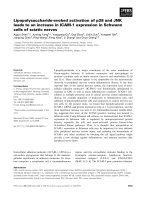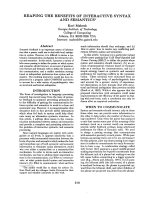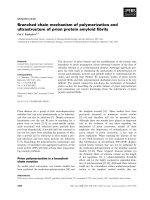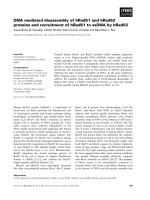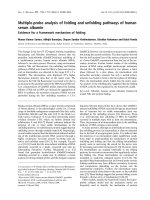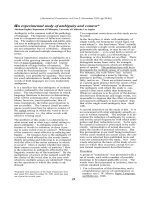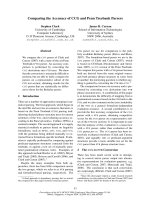Báo cáo khoa học: " Long term outcome of adolescent and adult patients with pineal parenchymal tumors treated with fractionated radiotherapy between 1982 and 2003 - a single institution’s experience" pot
Bạn đang xem bản rút gọn của tài liệu. Xem và tải ngay bản đầy đủ của tài liệu tại đây (216.45 KB, 7 trang )
RESEA R C H Open Access
Long term outcome of adolescent and adult
patients with pineal parenchymal tumors treated
with fractionated radiotherapy between 1982 and
2003 - a single institution’s experience
Eva Maria Stoiber
1*
, Benjamin Schaible
1
, Klaus Herfarth
1
, Daniela Schulz-Ertner
1,2
, Peter E Huber
1,3
, Jürgen Debus
1
,
Susanne Oertel
1
Abstract
Background: To evaluate the effectivity of fractionated radiotherapy in adolescent and adult patients with pineal
parenchymal tumors (PPT).
Methods: Between 1982 and 2003, 14 patients with PPTs were treated with fractionated radiotherapy. 4 patients
had a pineocytoma (PC), one a PPT with intermediate differentiation (PPTID) and 9 patients a pineoblastoma (PB), 2
of which were recurrences. All patients underwent radiotherapy on the primary tumor site with a median total
dose of 54 Gy. In 9 patients with primary PB treatment included whole brain irradiation (3 patients) or irradiation of
the craniospinal axis (6 patients) with a median total dose of 35 Gy.
Results: Median follow-up was 123 months in the PC patients and 109 months in the patients with primary PB. 7
patients were free from relapse at the end of follow-up. One PC patient died from spinal seeding. Among 5 PB
patients treated with radiotherapy without chemotherapy, 3 developed local or spinal tumor recurrence. Both
patients treated for PB recurrences died. The patient with PPTID is free of disease 7 years after radiotherapy.
Conclusion: Local radiotherapy seems to be effective in patients with PC and some PPTIDs. Diagnosis and
treatment of patients with more aggressive variants of PPTIDs as well as treatment of PB needs to be further
improved, since local and spinal failure even despite craniospinal irradiation (CSI) is common. As PPT are very rare
tumors, treatment within multi-institutional trials remains necessary.
Background
The pineal gland is an endocrine gland whic h is respon-
sible for the synthesis and secretion of melatonin.
Tumors originating from the pineal region are very rare.
They account for less than 1% of all primary central
nervous system t umors [1]. The y represent a very het-
erogeneous pa thologic collective. Many types of central
nervous system tumors like gliomas, meningeomas,
choroid plexus papillomas and ependymomas can occur
in the pineal region. The most common tumors in the
pineal region, however, are germ cell tumors. This
tumor entity constitutes about 21-70% of all pineal
region tumors.
Pineal parenchymal tumors (PPT) are the second lar-
gest subgroup of pineal tumors and represent about
10-30%. They derive from pinealocytes, the cells the
pineal gland is predominantly composed of. According to
the WHO classification for tumors of the central nervous
system revised in 2007, PPTs are subdivided into well-
differentiated pineocytomas (PC), PPT with intermediate
differentiation (PPTID) and p oorly differentiated pineo-
blastomas (PB) [2]. In general, survival of patients with
PPT is considered much more doubtful compared to that
of patients with other pineal region tumors [1].
Among the P PT, PC are considered the slowes t-grow -
ing with the most favorable overall survival rates. In
* Correspondence:
1
Department of Radiation Oncology, University Hospital Heidelberg, INF 400,
69120 Heidelberg, Germany
Full list of author information is available at the end of the article
Stoiber et al. Radiation Oncology 2010, 5:122
/>© 2010 Stoiber et al; licensee BioMed Central Ltd. This is an Open Access article distributed under the terms of the Creative Commons
Attribu tion License ( which permits unrestri cted use, distribution, and reproduction in
any med ium, provided the original work is properly cited.
contrast, PB represent t he most primitive form of all
PPT and histologically correspond to WHO grade IV
tumors. They are one category of the heterogeneous,
aggressive group of supratento rial primitive neuroecto-
dermal tumors (sPNETs). Local recurrence and spread
through the cerebro-sp inal fluid tract are common. Due
to the rare incidence of PPT there is ongoing debate
regarding their therapeuti c manage ment. We retrospec-
tively evaluated the long-term outcomes of our adoles-
cent and adult patients with pineal parenchymal gland
tumors treated with radiation therapy, to identify out-
come, possib le prognostic factors and patterns of failure
in our patients.
Materials and methods
Record review
We performed a retrospective analysis including all
patients with the histological diagnosis of a pineocy-
toma, PPT with intermediate differentiation or a pineo-
blastoma, who have been treated at our department of
radiation oncology since 1982. Clinical data were col-
lected, including age, extent of disease at diagnosis,
initial treatment including re section status and details of
radiation therapy (fields and doses) as well as informa-
tion regarding recurrence pattern. In case of relapse,
salvage treatment was documented. Information con-
cerning early and late side effects were collected from
the patient files. The extent of surgical tumor resection
was assessed from the surgical and pathological reports
and from postoperative imaging. If there was no evi-
dence of contrast-enhancing tumor left on the post-
operative imaging, patients were assi gned a “Gross total
resection (GTR)”. “R2-resection” was defined as any sur-
gical tumor resection less than GTR. The third category
was “Biopsy only”, for patients considered inoperable,
whenabiopsyonlywasperformedforobtainingthe
tumor histology. Fo r documentation of spinal seeding
Chang M-stage classification was used. CSF cytology
sampling was carried out inconsistently, especially in the
1980s and early 1990s, and was therefore not available
in most patients. Time of disease progression was calcu-
lated from the end of radiotherapy treatment to the date
of radiological local or cerebral/spinal tumor progres-
sion. Overall survival and local control rates were calcu-
lated from the end of radiotherapy treatment. Endpoint
of the analysis was either the date of last follow-up or
date of death.
Patient demographics and previous treatment
Fourteen patients with PPT were treated between 1982
and 2003. 4 patients suffered from a pine ocytoma, 1
from a P PTID and 9 patients from a pineoblastoma, 2
of which were recurrences. 10 patients were female,
among them 2 with a pineocytoma and the patient
with the PPTID. The median age at time of radiation
treatment was 40 years (19-47 years) for the PC
patients and 22 years (range 14-57 years) for the pine-
oblastoma patients (table 1). The patient with the
PPTID was 25 years old at the time of t reatment. At
presentation, 3 of the patients with p ineoblastoma had
evidence of cere bral or spinal seeding (M+ disease).
None of our patients suffered from extra-neural metas-
tases. In all patients stereotactic biopsy for histological
confirmation had been performed. None of the pineo-
cytoma, but 4 of the patients with pineoblastoma had
undergone gross or partial tumor resection. Two out
of the 7 patients with primary pineoblastoma received
chemotherapy prior to radiotherapy: A 17 female year-
old patient (patient 11) was treated with chemotherapy
according to the HIT 89 protocol after R2-resection.
No cerebral or spinal seeding was present at time of
diagnosis. One 14 year-old girl (patient 12) with spinal
seeding at time of diagnosis received chemotherapy
according to the HIT SKK 2000 protocol first, followed
by autologous stem cell transplantation and percuta-
nous radiation treatment afterwards.
Two patients with pineoblastoma were treated for
tumor recurrence. Both had previously undergone inter-
stitial brachytherapy in other departments and were
now treated with CSI plus local boost: A 14 year-old
patient (patient 13) was treated for local tumor recur-
rence after initia l treatment with iodineseed brachyther-
apy (TD 60 Gy) 7 months e arlier. This patient showed
additional cerebral tumor manifestation on MRI at the
time of re-radiation. A second, 25 year-old woman
(patient 14) was treated in our department after pre-
vious iodine-seed brachytherapy twice at two different
tumor sites, 4 years a nd 10 months earlier. Both times,
a TD of 60 Gy each had been administered, first to the
pineal gland tumor and later to a suprasellar metastasis.
Prior to both brachytherapy approaches a stereotactic
biopsy had been performed, which revealed the histolo-
gical diagnosis of a pineocytoma in both lesions. Prior
to the percutaneous radiation treatment a third biopsy
was taken, this time histology proved a pineoblastoma
in the pineal lesion. In this patient, there was also evi-
dence of cerebral seeding at the left temporal lobe at
the time of fractionated radiation treatment.
Radiotherapy
All patients were treated with percutaneous fractionated
radiotherapy, none with radiosurgery. Single doses var-
ied between 1,8 and 2 Gy (median 2 Gy) in all patients.
For the pineocytoma patients the median administered
radiation dose to the primary tumor site was 54 Gy (50-
56 Gy). None of the patients received radiation to the
whole brain or craniospinal axis in the primary setting.
Stoiber et al. Radiation Oncology 2010, 5:122
/>Page 2 of 7
In the patient with pineocytoma with intermediate dif-
ferentiation, the gross tumor volume was irradiated up
to a TD of 54 Gy in single fractions of 1.8 Gy.
Among the 7 patients with primary pineoblastoma, 3
received whole brain irradiation (patients 7, 8 and 11),
in 4 patients the whole craniospinal tract was treated.
Irradiation of the whole brain or the craniospinal tract
was performed with a median dose of 35 Gy (30-40 Gy).
The craniospinal axis was also treated in both patients
with pineoblastoma recurrences. In a ll pineoblastoma
patients a boost to the pineal tumor with a median TD
of 54.2 Gy (50-60 Gy) w as administered. Patient 12
additionally received a boost to the spinal metastasis
(TD 50 Gy).
Results
Outcome in patients with pineocytoma and PPTID
The median duration of follow-up was 123 months
(10.25 years) for the 4 pineocytoma patients (range
71-242 months). At the e nd of follow-up 3 patients
were still alive and remained free of disease. Patient 3
developed late cerebral and spinal tumor seeding 46
months after radiation treatment and underwent salvage
radiotherapy to the spinal axis with a TD of 39.6 Gy.
She died 28 months later due to progressive disease.
The patient with pineocytoma with intermediate dif-
ferentiation has remained free of disease for 84 months
(7 years).
Outcome in pineoblastoma patients
The median duration of follow-up was 109 months (9.1
years, range 3-321 months) for the 7 patients with
primary p ineoblastoma. Out of 5 patients who received
radiation therapy alone, one patient developed a distant
failure, one developed a local recurrence, and one
patient developed both. All patients had received radia-
tion treatment to the whole neuroaxis (<36 Gy). Both
patients (6 and 9) who developed local failures had
received a dose of less than 54 Gy to the local tumor.
One patient (10) developed a distant failure despite
treatment of the neuraxis with 32 Gy.
Among the 2 patients who were treated according to a
multimodal treatment protocol, one patient (12) with M1
disease at presentation relapsed and died. The second
patient (patient 11) is fine 250 months after treatment.
Both patients (13 and 14) treated with CSI for pineoblas-
toma recurrences after initial iodine-seed brachytherapy
died.
Patient 6 presented with a spinal metastasis 47 months
after radiation treatment and also developed local recur-
rence in the pineal region 89 months after RT. This
patient was initially treated with a TD of 35 Gy to the
neuraxis. Salvage treatment of the local tumor recurrence
consist ed of iodine-seed brachytherapy, the spinal metas-
tasis in the lumbar region was re-radiated percutaneously
(TD 19,8 Gy). 18 months later the patient received che-
motherapy (cisplatin and etoposid) due to progressive
disease, which was switched to gemcitabine 14 months
later. The patient died shortly afterwards due to further
tumor progression.
Patient 7 received radiotherapy only and has remained
free of disease.
Patient 8 was lost to follow-up 3 months after radia-
tion treatment.
Table 1 Patient characteristics
Patient Age
(Gender)
Histology Year M
1)
Resection Previous
treatment
RT
field
2)
Total dose
(boost) [Gy]
Alive
(Recurrence)
Follow-up (Time to
Progression) [months]
1 19 (m) PC 1988 0 B - GTV 50 yes (no) 242
2 44 (f) PC 1995 0 B - CTV 14 (56) yes (no) 172
3 52 (f) PC 1999 0 B - CTV 40 (54) no (yes) LF+SF(46)
4 37 (m) PC 2003 0 B - GTV 54 yes (no) 71
5 25 (f) PPTID 2002 0 B - GTV 54 yes (no) 84
6 40 (f) PB 1990 0 R2 - CSI 35 (50) no (yes) SF/LF(47/89)
7 17 (m) PB 1982 0 B - WB 40 (60) yes (no) 321
8 57 (m) PB 1995 0 B - WB 34 (54) yes (no) 3
9 28 (f) PB 1996 0 R2 - CSI 36 (52) yes (yes) LF (59)
10 22 (f) PB 2000 0 R2 - CSI 32 (59) yes (yes) LF+SF (13)
11 16 (f) PB 1990 0 R2 CHT (HIT 89
Protocol)
WB 30 (52) yes (no) 250
12 13 (f) PB 2001 3 B CHT (HIT 2000
Protocol)
CSI 40 (60) no (yes) SF (18)
13 14 (f) PB 1995 2 B iodine-seed BT CSI 34 (54) no (yes) LF (12)
14 25 (f) PB 1997 2 B iodine-seed BT CSI 36 (56) no (yes) LF (6)
1)
M stage prior to external beam radiation,
2)
star indicates additional boost to the primary tumor site, GTV: gross tumor volume, CTV: clinical tumor volume, WB:
whole brain, CSI: craniospinal irradiation, B: Biopsy only, R2: any surgical resection less than gross total resection. LF: local failure, SF: Spinal failure.
Stoiber et al. Radiation Oncology 2010, 5:122
/>Page 3 of 7
Patient 9 developed local tumor recurrence in the
pineal region 5 9 months a fter initial treatment of the
neuraxis. The patient was re-irradiated locally (TD 36
Gy) and is alive and free of disease 123 months after
radiation treatment.
Patient 10 developed diffuse cerebral and spinal tumor
recurrences 13 months after treatment. Salvage che-
motherapy was successful and the patient is still alive 31
months later.
Patient 11 has remained free of disease 250 months
after multimodal treatment.
Patient 12 suffered from cerebral and spinal tumor
recurrence 18 months after initial multimodal treatment.
In the following 14 months she received different
salvage chemotherapy regimens with Mafosfamid first,
followed by temozolomide and Roaccutan. Despite reir-
radiation to a metastasis at the cavernous sinus (TD
57,2 Gy) and in the lumbar spine (TD 30 Gy) the
patient died 6 months after completion of RT from
tumor progression.
Patient 13 developed cerebral tumor progression 12
months after treatment with fractionated radiotherapy.
Salvage chemotherapy (PCV) was initiated, but the girl
deceased 6 months later.
Patient 14 developed tumor progression of the supra-
sellar tumo r 6 months after fractionated radiation ther-
apy. Reirradiation with stereotactic radiosurgery was
performed (TD 12.5 Gy@80% isodose). The patient also
developed spinal tumor seeding 11 months later and
died shortly afterwards.
Toxicity
There were no severe early or late side effects due to
fractionated local radiation therapy observed in the
patients with pineocyt oma. In two patients visual
impairme nt improved substantially until the first follow-
up visit 3 months after treatment. 2 of the 9 pineoblas-
toma patients suffered from sepsis due to leucopenia
during CSI. No neurotoxicity was observed. Both
patients <14 years treated with CSI died within 2 years
after treatment, therefore no patient was at risk for
growth retardation in our collective. One Patient (7) had
to be treated for complete panhypopituitarism 40
months after whole brain irradiation with boost.
Discussion
While fractionated local radiotreatment of pineocyto-
mas seems to be a safe and effective method with a
local control rate of 100% in our small collective,
intensification of therapy in aggressive variants of
intermediate pineocytomas as well as pineoblastoma
seems necessary. Despite the small patient cohort, the
results of this analysis support those of other published
series.
Impact of exact histological grading
In terms o f overall survival and disease relapse 3 of 4
patients primarily diagnosed with pineocytoma could be
cured by local radiotherapy only, whereas curation by
radiation only failed in most patients with pineoblasto-
mas, even in case of CSI. Considering that also one of
our patients treated for pineocy toma experienced spinal
seeding, therefore suggesting a more aggressive tumor
variant, and that two of the patients referred with a
pineoblastoma had primarily been diagnosed with pineo-
cytoma years earlier, the difficulty and necessity of exact
histological grading prior to the choice of treatment,
including the size of radiation fields becomes once more
apparent. Careful histopathological classification is
required in order to identify mixed- or intermediate
typed pineocytomas. The exact differentiation of these
intermediate typed pineocytomas, formerly also referred
to as mixed pineocytoma-pineoblastoma, however,
remains difficult [3,4]. After correlat ion of histopatholo-
gical findings and prognosis of 66 patients with PPT
Jouvet et al [3] have suggested a further differentiation
amongst the PPTIDs, differing those with less than 6
mitoses and positive immunolabeling for neurofilaments
(less aggressiv e) from those with 6 or more mitoses and
a lack of neurofilament staining (more aggressive).
In the pineocytoma patients of our series histological
diagnosis was reached by stereotactic biopsy only, none
of the patients underwent open resection. This increases
the likelihood of misdiagnosis, since in small tissue sam-
ples potentially less-differentiated tumor cells might be
missed. This may also explain the disparity between the
suspected benign histology and the aggressive effects in
the patients men tioned above. Obtaining a maximal
amount of viable tissue for pathological examination is
crucial for accurate histological diagnosis of a
pineocytoma.
Impact of extent of disease
The impact of extent of disease in posterior fossa
PNETs (e.g. medulloblastoma) is well known, but it is
less well studied for sPNETs like PB. Howev er, Fauchon
et al [5] previously confirmed, that also in PPTs the
local tumor volume is a significant prognostic factor.
Tumor size influenzed both survival and the risk of peri-
operative complications in Fauchon’s study. Radical sur-
gery did not improve survival significantly, however, a
trend towards a longer disease-free survival after com-
plete resection was seen. For childre n with PB, an older
study of the children’s cancer group (CCG-921) showed
a clear negative impact of M1+ at presentation [6].
Nevertheless few authors noted that favourable out-
comes for a subset of M+ patients treated are possible
[7,8]. In our analysis, the patients initially presented
with M+ disease showed impaired overall survival.
Stoiber et al. Radiation Oncology 2010, 5:122
/>Page 4 of 7
Recurrent Pineoblastomas
Both patients treated for tumor recurrence after initial
treatment with interstitial brachytherapy died, even
though the administered radiat ion dose was similar to
the dose prescribed in the primary sett ing. Some newer
treatment protocols for recurrent sPNET use surgery
and chemotherapy to minimize residual disease first, fol-
lowed by high dose chemotherapy and autologous stem
cell rescue as a possible curative salvage treatment [9].
However, so far reported survival outcome for patients
with recurrent PB has remained poor, even though cura-
tion seems to be possible (patient 9 and 10). It should
be noted here that previous treatment with interstitial
brachytherapy, however, did not eliminate the possibility
of later external beam irradiation in these cases of
tumor recurrence.
Due to the rare incidence of PPT, most of the pub-
lished series a nalyzed long time periods retrospectively.
Therefore differences in workup, diagnosis and treat-
ment modalities are unavoidable and comparison of the
data of a long time period is difficult. PPT are not a
homogeneous histological tumor entity. According to
the 2007 WHO Classification of tumors of the central
nervous syste m they are classified in to 3 groups: Pineo-
cytomas, PPT with intermediate differentiation and
pineoblastomas [2]. Many older published series sepa-
rated PPT even in only two histological subtypes, PC
and P B. No intermediat e differentiated PPTs, classified
as WHO grade II-III tumors, according to the new
WHO classification system, were documented. Since
there is a large pathologic variability among PPT it is
difficult to draw general conclusions about their beha-
vior. Local control, the potential to seed among the cer-
ebro-spinal fluid path and overall survival varies widely
among the heterogeneous collective of PPTIDs.
Among the PPT, pineocytoma s are considered the
slowest-growing with the most favorable overall 5- year
survival rates. Histologically they represent WHO grade
I tumors [2]. In patients treated with surgery and/or
radiosurgery, 5-year overall survival rates of up to 90%
have been reported [7,8]. Publications on the use of sole
local fractionated radiotherapy in the management of
pineocytomas are rare. Several retrospective studies ana-
lyzing the long-term outcome of patients treated with
radiosurgery exist. These studies give evidence that
radiosurgery constitutes a comparably safe and very
effective treatment for PPT [10-13] both as a tool in a
multidisciplinary treatment approach, or as a single
mean in selected cases. Tumor size decreases by up to
70% and even complete regressions have been described
[14] as well as excellent local tumor control rates of up
to 100% for small tumors [10]. In an older analysis with
only five patients, Vaquer o et al. [15] showed that post-
operative radiation after surgical removal can be
omitted, even in case of local invasion in PPTs with
neuronal differentiation. Especially in older studies,
pineocytomas, however, did sometimes not behave as
benign as expected, particularly in younger patients
[16-18]. Also among our four patients with pineocytoma
one patient developed spinal seeding, t hus suggesting a
more aggressive tumor variant. Obtaining a maximal
amount of tissue sample is therefore crucial in suspected
pineocytomas, to decrease the likelihood of a histologi-
cal misdiagnosis as a possible cause for this aggressive
behavior. Kurisaka et al [16] were able to show, that
additional radiotreatment does improve 5-year local sur-
vival in PPTIs from 83% to 43%, possibly because in the
data held as PPTs by the All Japan Brain Tumor Regis-
try aggressive PPTIDS may have been included. Yet,
close follow-up including MRI of the neuraxis is recom-
mended for all patients with PPT to detect recurrence
at an early state, sinc e successful salvage therapy is
possible.
Pineoblastomas are classified as PNETs. The main
indicators of prognosis for PB seem to be histopatholo-
gical diagnosis and staging of the neuraxis [19]. Like
other PNETs they tend to metastasize widely through-
out the CSF pathway. Even the occurence of extra-
neural metastases in PB patients has been described
[20]. Since PNETs often relapse locally, it is also neces-
sary to establish exact criteria for local RT planning
[21]. In our cohort, 2 patients with primary pineoblas-
tom a and both patients with pineoblastoma recurrences
developed local failure. Up to date there is no generally
accepted therapeutic approach in the primary treatment
of pineoblastomas. Dose escalation within the pineal
tumor (e.g. via a particle therapy boost or prec ision
photon RT or radiosurgery) is currently one of the treat-
ment strategies investigated in clinical trials. Excellent
local control rates in patients who recieved doses
equivalent to >50 Gy fractionated radiation, compared
to patients treated with lesser doses have been observed
by Schild et al [22]. But his study not only included PB
patients, but also patients with PPT with intermediate
differentiation, mixed tumors and pineocytoma.
Patients ≤21 years of age are usually included in the
HIT-2000 protocol, which stratifies radiation therapy
according to risk profile. E.g. in M+ patients, intensi-
fied sandwich chemotherapy is combined with hyper-
fractionated radiotherapy with loca l doses of up to 40
Gy to whole brain and craniospinal axis, and boosts up
to 72 Gy locally. Published data also suggest that com-
bined treatment consisting of gross tumor resection,
CSI and multi-agent chemotherapy correlate with
improved survival in pediatric pineoblastoma patients
[7]. In order to reduce radiation induced late effects,
other g roups are invest igating risk-adapted cranio spinal
radiotherapy as part of a multimodal treatment approach.
Stoiber et al. Radiation Oncology 2010, 5:122
/>Page 5 of 7
E.g. Chintagumpala undertook a study to estimate the
event free survival (EFS) of patients with newly diagnosed
supra tentorial PNETs treated with risk-adapte d CSI with
addition al radiation to the primary tumor site and subse-
quent high-dose chemotherapy supported by stem cell res-
cue [23]. 7 of 16 enrolled patients had pineal PNETs, 5 of
them with high-risk disease defined as metastatic disease
in the brain or spine, or presence of residual disease >1.5
cm
2
. Patients received risk-adapted CSI with 23.4 Gy in
case of M0 patients ("average-risk patients”) and 36-39 .6
Gy for highrisk patients. Overall, the 5-year EFS for all 7
pineoblastoma patients was 54% with an overall survival of
67%. The authors conclude that the doses to the craniosp-
inal axis might be reduced in a subset of patients without
compromising event-free survival [23].
Conclusion
Despite its limitation by smal l patient numbers, the pre-
sented study adds further evidence to the importance of
an improvement of histological diagnosis and classifica-
tion. While local radiotherapy of patients with pineocy-
toma seems to be safe and effective, intensification of
treatment in some PPTID and pineoblastoma patients
by addition of chemotherapy and/or radiation therapy
within clinical trials seems t o be warranted, since local
and spinal failures are common after RT. Close follow-
up after treatment is important, since salvage therapies
can be effective.
Acknowledgements
The work was supported by the University of Heidelberg, Germany, through
a young investigator award.
Author details
1
Department of Radiation Oncology, University Hospital Heidelberg, INF 400,
69120 Heidelberg, Germany.
2
Department of Radiation Oncology, Markus
Krankenhaus, Wilhelm Epstein-Strasse 4, 60431 Frankfurt am Main, Germany.
3
Department of Radiation Oncology, German Cancer Research Center, INF
280, 69120 Heidelberg, Germany.
Authors’ contributions
EMS is responsible for data acquisition, literature research and writing of the
manuscript. BS is responsible for data acquisition. PH, JD, KH and DSE are
responsible for the clinical treatment of the patients and concepts. SO is
responsible for literature research and proof reading. All authors read and
approved the final manuscript.
Competing interests
The authors declare that they have no competing interests.
Received: 10 October 2010 Accepted: 26 December 2010
Published: 26 December 2010
References
1. Al-Hussaini M, Sultan I, Abuirmileh N, Jaradat I, Qaddoumi I: Pineal gland
tumors: experience from the SEER database. J Neurooncol 2009,
94:351-358.
2. Louis DN, Ohgaki H, Wiestler OD, Cavenee WK, Burger PC, Jouvet A,
Scheithauer BW, Kleihues P: The 2007 WHO classification of tumors of the
central nervous systems. Acta Neuropathol 2007, 114:97-109.
3. Jouvet A, Saint-Pierre G, Fauchon F, Privat K, Bouffet E, Ruchoux MM,
Chauveinc L, Fèvre-Montange M: Pineal parenchymal tumors: a
correlation of histological features with prognosis in 66 cases. Brain
Pathol 2000, 10(1):49-60, Review.
4. Anan M, Ishii K, Nakamura T, Yamashita M, Katayama S, Sainoo M,
Nagatomi H, Kobayashi H: Postoperative adjuvant treatment for pineal
parenchymal tumour of intermediate differentiation. J Clin Neurosci 2006,
13(9):965-8, Epub 2006 Aug 14.
5. Fauchon F, Jouvet A, Paquis P, Saint-Pierre G, Mottolese C, Ben Hassel M,
Chauveinc L, Sichez JP, Philippon J, Schlienger M, Bouffet E: Parenchymal
pineal tumors: a clinicopathological study of 76 cases. Int J Radiat Oncol
Biol Phys 2000, 46(4):959-68.
6. Jakacki RI, Zeltzer PM, Boyett JM, Albright AL, Allen JC, Geyer JR, Rorke LB,
Stanley P, Stevens KR, Wisoff J: Survival and prognostic factors following
radiation and/or chemotherapy for primitive neuroectodermal tumors of
the pineal region in infant and children: a report of the children’s
cancer group. J Clin Oncol 1995, 13(6):1377-1383.
7. Gilheeney SW, Saad A, Chi S, Turner C, Ullrich NJ, Goumnerova L, Scott RM,
Marcus K, Lehman L, De Girolami U, Kieran MW: Outcome of pediatric
pineoblastoma after surgery, radiation and chemotherapy. J Neurooncol
2008, 89(1):89-95.
8. Gururangan S, McLaughlin C, Quinn J, Rich J, Reardon D, Halperin EC,
Herndon J, Fuchs H, George T, Provenzale J, Watral M, McLendon RE,
Friedman A, Friedman HS, Kurtzberg J, Vredenbergh J, Martin PL: High-dose
chemotherapy with autologous stemcell rescue in children and adults
with newly diagnosed pineoblastomas. J Clin Oncol 2003,
21(11):2187-2191.
9. Broniscer A, Nicolaides TP, Dunkel IJ, Gardner SL, Johnson J Jr, Allen JC,
Sposto R, Finlay JL: High dose chemotherapy with autologous stem-cell
rescue in the treatment of patients with recurrent non-cerebellar
primitive neuroectodermal tumors. Pediatr Blood Cancer 2004, 42(3):261-7.
10. Hasegawa T, Kondziolka D, Hadjipanayis CG, Flickinger JC, Lunsford LD: The
role of radiosurgery for the treatment of pineal parenchymal tumors.
Neurosurgery 2002, 51:880-889.
11. Mori Y, Kobayashi T, Hasegawa T, Yoshida K, Kida Y: Stereotactic radiosurgery
for pineal and related tumors. Prog Neurol Surg 2009, 23:106-18.
12. Kano H, Niranjan A, Kandziolka D, Flickinger JC, Lunsford D: Role of
stereotactic radiosurgery in the management of pineal parenchymal
tumors. Prog Neurol Surg 2009, 23:44-58.
13. Manera L, Regis J, Chinot O, Porcheron D, Levrier O, Farnarier P, Peragut JC:
Pineal region tumors: The role of stereotactic radiosurgery.
Stereotact
Funct Neurosurg 1996, 66:164-173.
14. Reyns N, Hayashi M, Chinot O, Manera L, Peragut J-C, Blond S, Regis J: The
role of Gamma Knofe radiosurgery in the treatment of pineal
parenchymal tumors. Acta Neurochir 2006, 148:5-11.
15. Vaquero J, Ramiro J, Martínez R, Coca S, Bravo G: Clinicopathological
experience with pineocytomas: report of five surgically treated cases.
Neurosurgery 1990, 27(4):612-8, discussion 618-9.
16. Kurisaka M, Arisawa M, Mori T, Sakamoto T, Seike M, Mori K, Okada T,
Wakiguchi H, Kurashige T: Combination chemotherapy (cisplatin,
vinblastin) and low-dose irradiation in the treatment of pineal
parenchymal cell tumors. Childs Nerv Syst 1998, 14(10):564-9.
17. Marsh WR, Laws ER Jr: Shunting and irradiation of pineal tumors. Clin
Neurosurg 1985, 32:384-396.
18. Disclafani A, Hudgins RJ, Edwards MS, Wara W, Wilson CB, Levin VA:
Pineocytomas. Cancer 1989, 63:302-394.
19. Lutterbach J, Fauchon F, Schild S, Chang S, Pagenstecher A, Volk B,
Ostertag C, Momm F, Jouvet A: Malignant pineal parenchymal tumors in
adult patients: patterns of care and prognosic factors. Neurosurgery 2002,
51:44-56.
20. Frasen G, Rampling R, Smith C, Nicoll J, Stephan M: Long term survival
following extra-neural metastasis from a pineaoblastoma. J Neurooncol
2000, 48:141-144.
21. Taylor RE, Donachie PH, Weston CL, Robinson KJ, Lucraft H, Saran F,
Ellison DW, Ironside J, Walker DA, Pizer BL: Impact of radiotherapy
parameters on outcome for patients with supratentorial primitive neuro-
ectomdermal umors entered into the SIOP/UKCCSG PNET 3 study.
Radiother Oncol 2009, 92:83-88.
22. Schild SE, Scheithauer BW, Schomberg PJ, Hook CC, Kelly PJ, Frick L,
Robinow JS, Buskirk SJ: Pineal parenchymal tumors. Clinical, pathologic,
and therapeutic aspects. Cancer 1993, 72(3):870-80, Review.
Stoiber et al. Radiation Oncology 2010, 5:122
/>Page 6 of 7
23. Chintagumpala M, Hassall T, Palmer S, Ashley D, Wallace D, Kasow K,
Merchant TE, Krasin MJ, Dauser R, Boop F, Krance R, Woo S, Cheuk R, Lau C,
Gilbertson R, Gajjar A: A pilot study of riskadapted radiotherapy and
chemotherapy in patients with supratentorial PNET. Neuro Oncol 2009,
11(1):33-40.
doi:10.1186/1748-717X-5-122
Cite this article as: Stoiber et al.: Long term outcome of adolescent and
adult patients with pineal parenchymal tumors treated with
fractionated radiotherapy between 1982 and 2003 - a single
institution’s experience. Radiation Oncology 2010 5:122.
Submit your next manuscript to BioMed Central
and take full advantage of:
• Convenient online submission
• Thorough peer review
• No space constraints or color figure charges
• Immediate publication on acceptance
• Inclusion in PubMed, CAS, Scopus and Google Scholar
• Research which is freely available for redistribution
Submit your manuscript at
www.biomedcentral.com/submit
Stoiber et al. Radiation Oncology 2010, 5:122
/>Page 7 of 7
